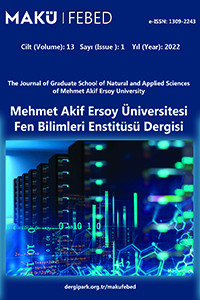Alttaş sıcaklığının expanding thermal plazma yöntemi ile elde edilen a-Si:H filmlerin optik ve elektriksel özellikleri üzerine etkisi
Optical properties and dark current activation energy of hydrogenated amorphous silicon (a,Si:H) produced by the expanding thermal plasma chemical vapour deposition (ETPCVD) technique are investigated as a function of substrate temperature in the 150,500°C temperature range. The optical transmission spectra were used to obtain the thickness, refractive index, and optical band gap of the a, Si:H films. It is observed that while the refractive index is increasing with substrate temperature, the optical band gap and deposition rate, as well as the dark conductivity activation energy, are decreasing.
Anahtar Kelimeler:
Hydrogenated amorphous silicon, solar cell, optical parameters, optical transmittance.
Effects of substrate temperature on optical and electrical properties of a-Si:H films produced by expanding thermal plasma thecnique
Optical properties and dark current activation energy of hydrogenated amorphous silicon (a,Si:H) produced by the expanding thermal plasma chemical vapour deposition (ETPCVD) technique are investigated as a function of substrate temperature in the 150,500°C temperature range. The optical transmission spectra were used to obtain the thickness, refractive index, and optical band gap of the a, Si:H films. It is observed that while the refractive index is increasing with substrate temperature, the optical band gap and deposition rate, as well as the dark conductivity activation energy, are decreasing.
___
- Brinza, M. et al., (2002). J. Non-Cryst. Solids, 299, 420.
- Willekens, J. et al., (2004) Optical Spectrocopy of the Gap State Density in Etp-Deposited a-Si:H, Journal of Non-Crystalline Solids,338-340, 244-248.
- Güngör, T. (1998). Determination of optical constant and thickness for a-SiNx:H thin film, Journal of Research in Physics, 27, No.1, 1-9.
- Güngör, T. (2002). Turkish Journal of Physics, 26, 269 (2002).
- Güngör, T. & Saka, B. (2004). Calculation of the optical constants of a thin layer upon a transparent substrate from the reflection spectrum using a genetic algorithm, Thin Solid Films, 467, 319-325.
- Golikova, O. A. et al., (1997). Physics and Astronomy Semiconductors,Volume 31, Number 7, 691-694.
- Iakoubovskii, K. (2000) Optical Study of Defects in Diamond, PhD. Thesis, University of Leuven.
- Kessels, W. M. M. (2000). Remote Plasma Deposition of Hydrogenated Amorphous Silicon: Plasma Processes, Film Growth, and the Material Properties, PhD. Thesis, Eindhoven University of Technology.
- Kessels, W. M. M. et al., (2000). J. Vac. Sci. Technol. A., 18, 2153.
- Korevaar, B. A. et al., (2002). Proc. 29th IEEE Photovoltaic Conference.
- Smets, A. H. M., et al., (2000). J. Appl.Phys. 88, 6388.
- Swanepoel R. (1983). Determination of the thickness and optical constants of amorphous silicon, J. Phys., E. Sci. Instrum., 16, 1214-1222.
- Tauc, J., Grigorovici, R., & Vancu, A., (1966). Optical properties and electronic structure of amorphous germanium, Phys.Stat. Sol. 15, 627.
- Yayın Aralığı: Yılda 2 Sayı
- Başlangıç: 2010
- Yayıncı: Burdur Mehmet Akif Ersoy Üniversitesi
